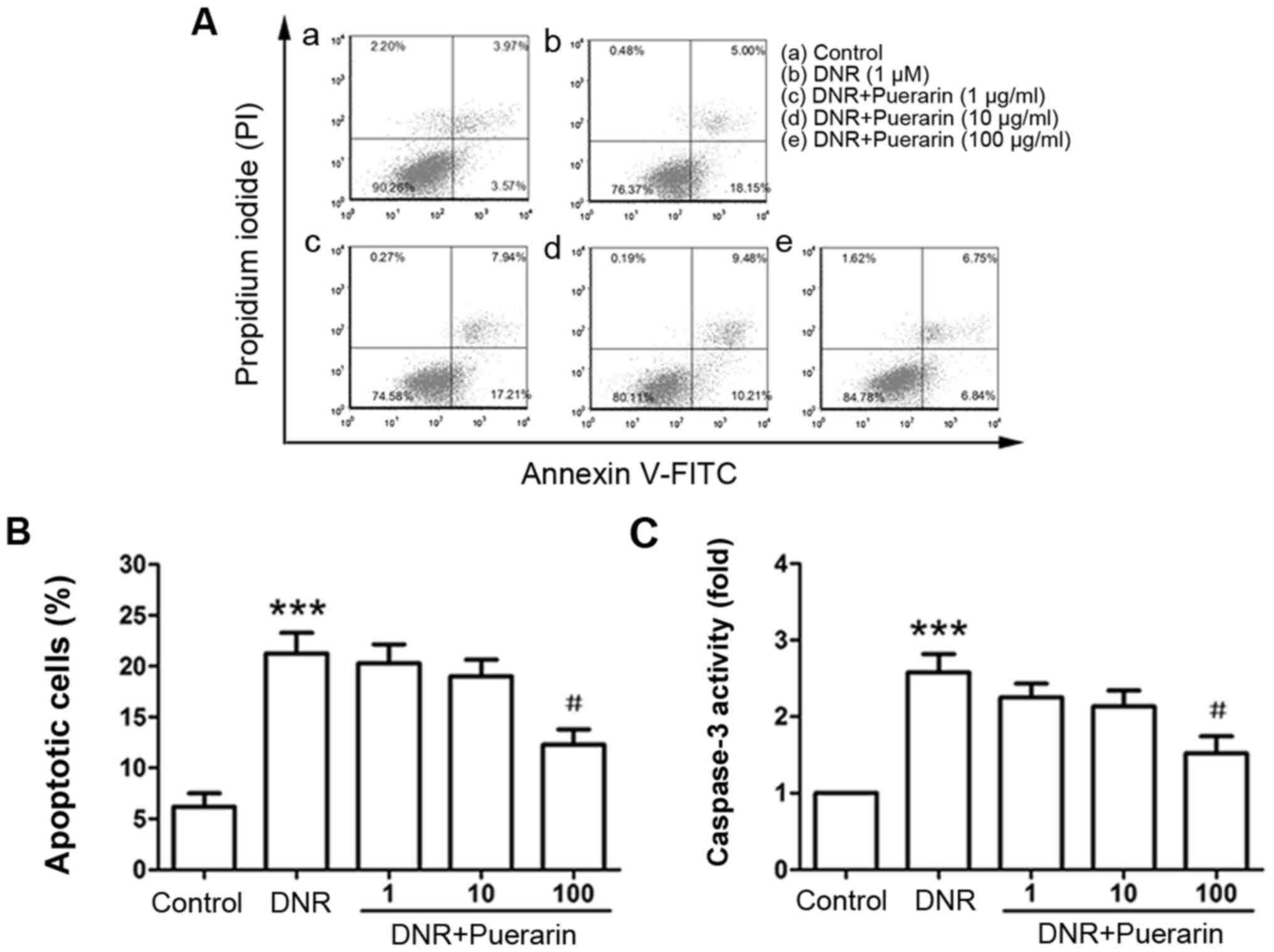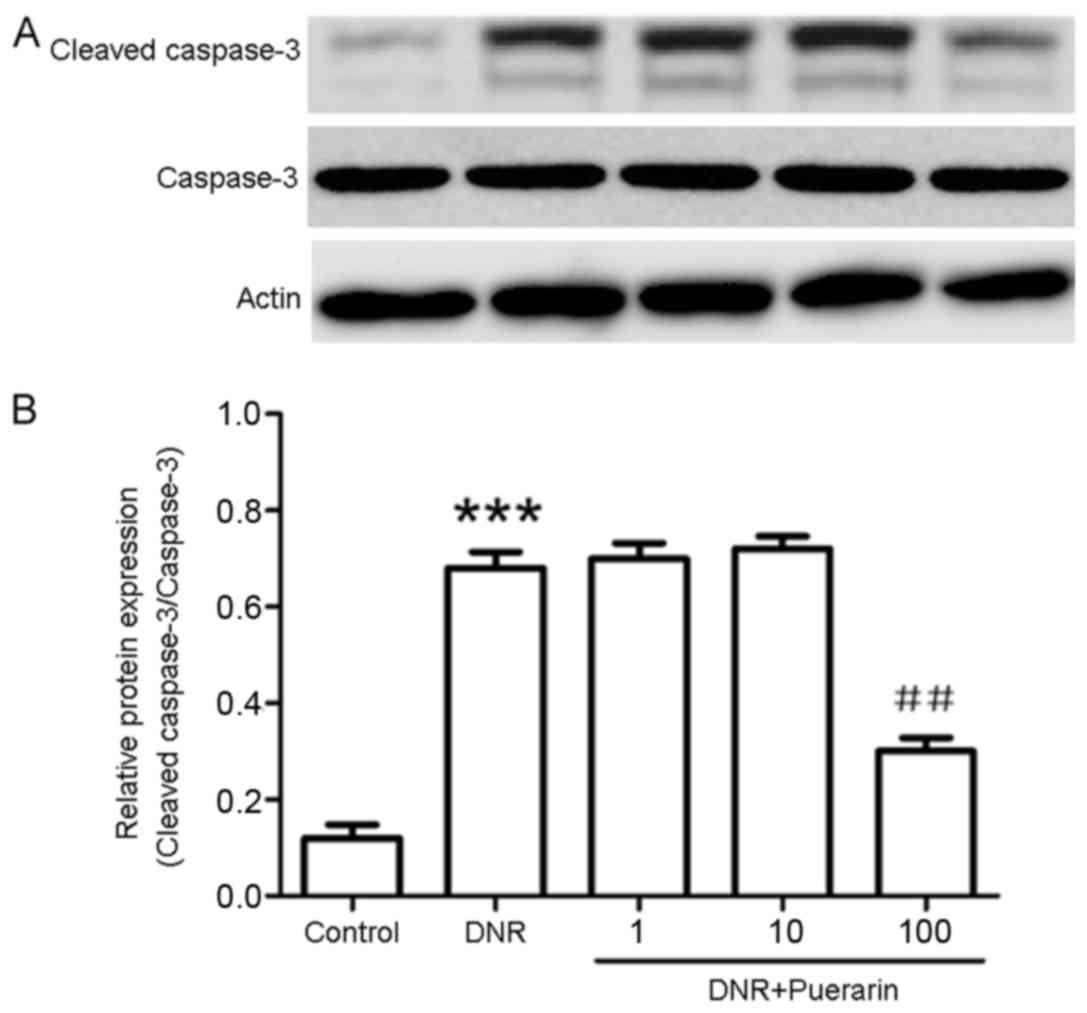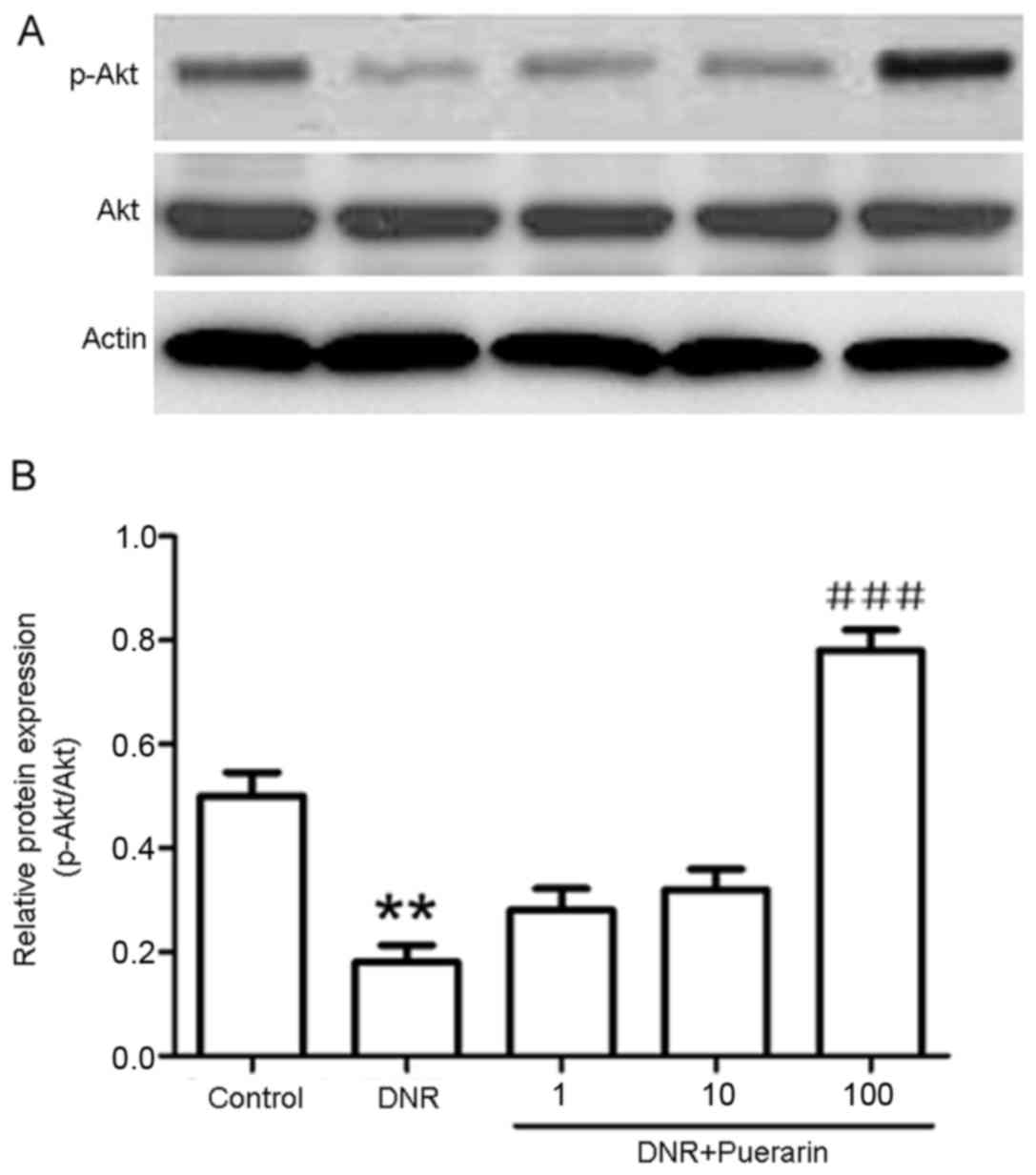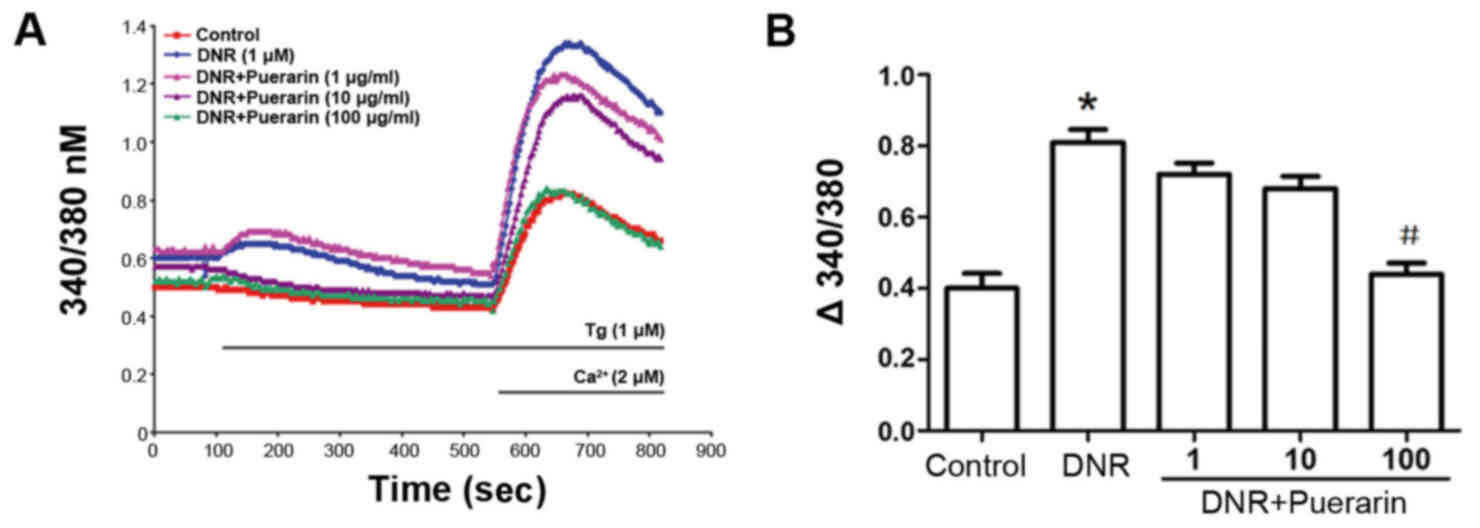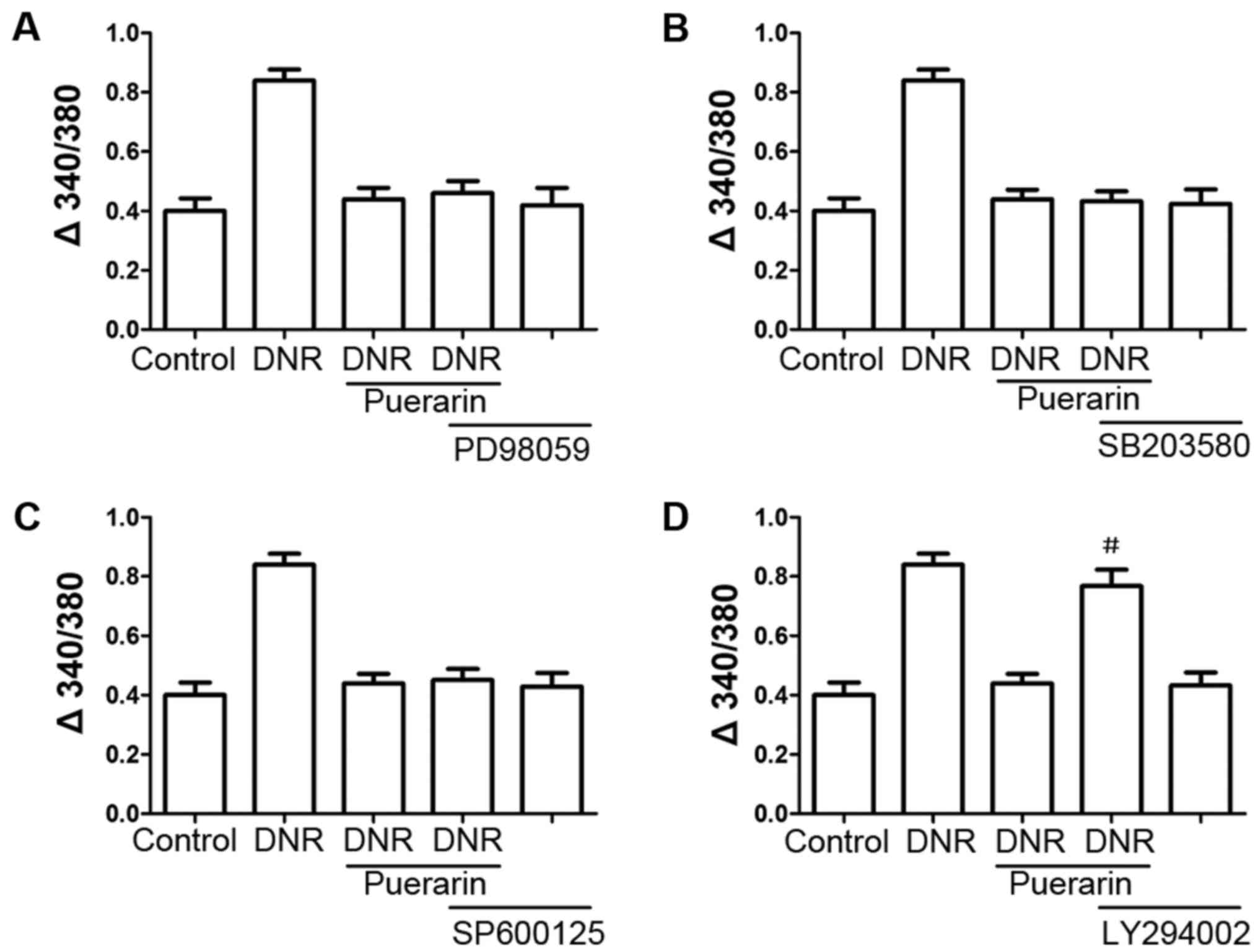Puerarin attenuates the daunorubicin-induced apoptosis of H9c2 cells by activating the PI3K/Akt signaling pathway via the inhibition of Ca2+ influx
- Authors:
- Published online on: October 12, 2017 https://doi.org/10.3892/ijmm.2017.3186
- Pages: 1889-1894
Abstract
Introduction
Daunorubicin (DNR), a anthracycline chemotherapeutic drug, is widely used in the treatment of various types of cancer, including acute leukemia, breast cancer, soft tissue sarcoma and aggressive lymphoma (1). However, the clinical application of DNR is always restricted due to its cumulative and dose- dependent cardiotoxicity (2). Increasing evidence indicates that cardio myocyte apoptosis may contribute to the progression of anthracycline-based cardiotoxicity (3). The mechanisms involved in DNR-induced cardiotoxicity include reactive oxygen species (ROS) production, caspase activation and cell cycle arrest, which ultimately result in cardiomyocyte apoptosis (4).
Cell apoptosis is an essential process which maintains the dynamic equilibrium under normal conditions (5). Calcium (Ca2+) is a pivotal regulator of cell survival, and the sustained elevation of intracellular Ca2+ concentrations can activate various Ca2+ signals connected to apoptosis (6). A recent study reported that BN52021, a platelet activating factor antagonist, protected H9c2 cells against DNR-induced death by decreasing Ca2+ influx and attenuating the activation of p38 mitogen-activated protein kinase (MAPK) signaling (7). In addition, as previously demonstrated, the overexpression of calreticulin suppresses phosphatidylinositol 3-kinase (PI3K)/Akt signaling and causes the increased apoptosis of H9c2 cells via altered Ca2+ homeostasis (8). Thus, it is suggested that the disruption of Ca2+ homeostasis can lead to caspase activation and subsequent cellular apoptosis (9).
The traditional Chinese medicine, puerarin, known as Ge-gen in Chinese, is isolated from Radix puerariae as an active component and possesses a series of pharmacological activities, including antioxidant, anti-osteoporotic, anti-inflammatory, anti-apoptotic, neuroprotective and cardioprotective properties (10). Puerarin can protect against apoptosis in a variety of cell types, including osteoblasts, microglia, neurons and cardiomyocytes (11–14). However, its role in the DNR-induced apoptosis of H9c2 cells and the underlying mechanisms remain unclear.
In this study, we demonstrate that puerarin attenuates H9c2 cell apoptosis induced by DNR by promoting the activation of the PI3K/Akt signaling pathway via the inhibition of Ca2+ influx. These findings provide new insight into the the detailed mechanisms underlying the cardioprotective effects of puerarin. Puerarin may thus have potential for use as an alternative drug in the treatment of cardiomyopathy indcued by DNR.
Materials and methods
Materials
Rat H9c2 cardiomyocytes were purchased from the Cell Bank of the Chinese Academy of Sciences (Shanghai, China). DNR was obtained from Pfizer, Inc. (New York, NY, USA). Specific inhibitors, including PD98059 (MAPK inhibitor), LY294002 (PI3K inhibitor), SB203580 (p38 MAPK inhibitor) and SP600125 (JNK inhibitor) were purchased from Sigma-Aldrich, (St. Louis, MO, USA).
H9c2 cell culture
H9c2 cells were cultured in Dulbecco's modified eagle's medium (DMEM) supplemented with 10% fetal bovine serum (FBS) and antibiotics (100 U/ml streptomycin and 100 U/ml penicillin) (all from Gibco Life Technologies, Carlsbad, CA, USA) at 37°C in a humified incubator with 5% CO2.
Cell treatments
The H9c2 cells were treated with various concentrations of puerarin (1–100 µg/ml; Sigma-Aldrich) for 24 h. The cells were then cultured for an additional 24 h in the presence of 1 µM DNR to induce cell apoptosis. The cells were then collected for use in the follow-up experiments.
Treatment of cells with signaling pathway inhibitors
The H9c2 cells were treated with various signaling pathway inhibitors, including ERK1/2 inhibitor (PD98059, 10 µM), PI3K inhibitor (LY294002, 10 µM), p38 MAPK inhibitor (SB203580, 10 µM) and JNK inhibitor (SP600125, 10 µM), for 30 min prior to the addition of puerarin. Following 24 h of incubation, the cells were treated with 1 µM DNR for 24 h. The suppressive effects of puerarin on DNR-induced apoptosis were then evaluated.
MTT assay
The H9c2 cell suspensions (5×104 cells/ml) were seeded in 96-well plates at approximately 200 µl per well, and 1×104 cells per well for MTT assay. At the end of the drug incubation, 3-(4,5-dimethylthiazol-2-yl)-2,5-diphenyltetrazolium bromide (MTT) (Sigma-Aldrich) working solution (0.5 mg/ml) was added, and the plates were incubated for an additional 4 h at 37°C. Following centrifugation, the medium was replaced with dimethyl sulfoxide (DMSO) (Sigma-Aldrich). The absorbance of each well at 570 nm was measured using a plate reader (Bio-Rad Laboratories, Inc., Hercules, CA, USA). Cell viability was calculated as follows: inhibitory rate of H9c2 cell viability (%) = (OD value of control group - OD value of test group) ×100%/OD value of control group.
Flow cytometric detection of apoptosis
The apoptotic cells were detected using a FITC Apoptosis Detection kit (BD Pharmingen, San Diego, CA, USA). The H9c2 cells were collected, washed and resuspended in buffer containing 5 µl of Annexin V-FITC and 5 µl of propidium iodide (PI). Following incubation for 15 min in the dark at room temperature, the fluorescence of the cells was analyzed using BD FACSCanto II with Diva software (BD Biosciences, San Diego, CA, USA). The apoptotic cells contained the early apoptotic cells (Annexin V+ and PI−) and the late apoptotic or necrotic cells (both Annexin V+ and PI+).
Enzymatic assay for caspase-3
Caspase-3 activity was detected using a Caspase-3 Activity Assay kit (BestBio, Shanghai, China). The cells were harvested and extracted on ice in lysis buffer for 15 min. The lysates were centrifuged and the supernatants were assessed for protein content. Subsequently, supernatant samples containing 50 µg proteins were incubated with 90 µl reaction buffer and 10 µl caspase-3 substrate (N-acetyl-Asp-Glu-Val-Asp-p-nitroanilide) at 37°C for 2 h in the dark. The optical density (OD) values were measured at 405 nm using a microtiter plate reader (Thermo Fisher Scientific, Inc., Waltham, MA, USA).
Western blot analysis
The H9c2 cells were collected, washed with ice-cold sterile phosphate-buffered saline (PBS), and lysed with RIPA buffer (50 mM Tris-HCl pH 7.4, 150 mM NaCl, 1 mM EDTA, 0.1% SDS, 0.2% deoxycholic acid and 1 mM PMSF, 1:100 protease inhibitor cocktail). The lysates were centrifuged and supernatants were analyzed for protein concentration using a BCA Protein Assay kit (Thermo Fisher Scientific, Inc). An equal amount of the proteins (30 µg) was separated by 10% SDS-PAGE and transferred onto a PVDF membrane. The blotted membrane was then blocked with 5% non-fat dry milk for 1 h at room temperature and incubated overnight at 4°C with primary antibodies [1:1,000, rabbit antibodies to cleaved caspase-3 (9661), caspase-3 (9665), phosphorylated Akt (p-Akt; 4058), Akt (4685) and mouse antibodies to β-actin (3700)] (Cell Signaling Technology, Inc., Danvers, MA, USA). The immunoreactive bands were further incubated with peroxidase-conjugated anti-mouse (7076)/rabbit (7074) secondary antibodies for 1 h at room temperature, were then detected by the enhanced chemiluminescence (ECL) method and captured using a scanner (HP Scanjet 7400C; Hewlett-Packard, Palo Alto, CA, USA). The protein intensities were quantified using ImageJ software (National Institutes of Health, Bethesda, MD, USA).
Cytosolic Ca2+ measurement
Ratiometric imaging of intracellular Ca2+ using cells loaded with Fura-2 was carried out as previously described (15). The H9c2 cells were grown in round coverslips (30 mm) under normal culture conditions, unless otherwise indicated. Coverslips with cells were placed in a cation-safe solution composed of 107 mM NaCl, 7.2 mM KCl, 1.2 mM MgCl2, 11.5 g lucose, 20 mM HEPES/NaOH (pH 7.3) and loaded with Fura-2/AM (2 µM final concentration) for 30 min at 37°C. The cells were washed, and de-esterification was allowed for a minimum of 15 min. Ca2+ measurements were made using a Leica DMI 6000B fluorescence microscope controlled by the slidebook software (Intelligent Imaging Innovations, Inc., Denver, CO, USA). Fluorescence emission at 505 nm was monitored, while alternating excitation wavelengths between 340 and 380 nm at a frequency of 0.5 Hz; intracellular Ca2+ measurements are shown as 340/380 nm ratio obtained from groups (15) of single cells. External solutions contained: 135 mM NaCl, 5.4 mM KCl, 10 mM HEPES, 0.02 mM NaH2PO4, 2 mM Mg2+, 10 g glucose (pH 7.4).
Statistical analysis
The results were analyzed with statistical analysis software SPSS 16.0 (SPSS, Inc., Chicago, IL, USA), and the values are represented as the means ± SD. Differences between 2 groups were evaluated using the Student's t-test. One-way analysis of variance (ANOVA) was used for multi-group comparisons with Tukey's post hoc test. A P-value <0.05 was considered to indicate a statistically significant difference.
Results
Puerarin suppresses DNR-induced cytotoxicity in H9c2 cells
When the H9c2 cells were treated with low concentrations of puerarin (1, 10 and 100 µg/ml), no significant changes in cell viability were observed apart from a slight decrease compared with the controls. However, the viability of the H9c2 cells was inhibited in a dose-dependent manner following treatment with higher concentrations of puerarin (250–1,000 µg/ml) (Fig. 1A), suggesting strong cytotoxicity to H9c2 cells treated with high concentrations of puerarin.
According to the inhibitory effects of puerarin at various concentrations on H9c2 cell viability (IC50=168.5 µg/ml) (Table I), a concentration range of puerarin (1, 10 and 100 µg/ml) was selected for use in this study. As shown in Fig. 1B, treatment with DNR significantly suppressed the viability of the H9c2 cells compared with the controls (P<0.01). Importantly, puerarin at 100 µg/ml markedly suppressed DNR-induced cytotoxicity (DNR vs. puerarin, 52.38±6.22% vs. 78.98±5.65%; P<0.05).
Puerarin inhibits the DNR-induced apoptosis of H9c2 cells
By flow cytometric analysis, we observed that DNR markedly induced the apoptosis of H9c2 cells (control vs. DNR, 6.21±1.30% vs. 21.25±2.05%, P<0.001). Pre-treatment with puerarin at 100 µg/ml significantly inhibited DNR-induced apoptosis (DNR vs. puerarin, 21.25±2.05% vs. 12.28±1.52%; P<0.05) (Fig. 2A and B). In line with the Annexin V/PI staining results, the enzymatic activity of caspase-3 was also markedly decreased following treatment with puerarin prior to exposure to DNR (P<0.05) (Fig. 2C).
Puerarin promotes p-Akt (Ser473) activation which is suppressed by DNR
As shown in Fig. 3, puerarin markedly decreased the DNR-induced protein expression of cleaved caspase-3 (P<0.01). In addition, treatment with DNR markedly suppressed the phosphorylation of Akt (Ser473) compared with the control (P<0.01). Conversely, treatment with puerarin prior to exposure to DNR evidently promoted p-Akt (Ser473) activation (P<0.001) (Fig. 4).
Puerarin restricts Ca2+ influx in H9c2 cells treated with DNR
As shown in Fig. 5, DNR induced an increment in Ca2+ influx in a time-dependent manner. Of note, puerarin clearly restricted the DNR-induced Ca2+ influx (P<0.05), suggesting that the inhibition of Ca2+ influx was involved in the cardioprotective effects of puerarin.
Puerarin attenuates DNR-induced apoptosis via the PI3K/Akt signaling pathway
We treated the H9c2 cells with various inhibitors, including PD98059, LY294002, SB203580 and SP600125 prior to treatment with puerarin. As shown in Fig. 6D, pre-treatment with the PI3K inhibitor, LY294002, markedly reversed the inhibition of Ca2+ influx by puerarin (P<0.05); however, the ERK inhibitor (PD98059), p38 MAPK inhibitor (SB203580) and JNK inhibitor (SP600125) (Fig. 6) did not exert any significant effects.
Discussion
At present, the avoidance of the cardiotoxic side-effects of DNR without compromising its antitumor efficacy in clinical treatment is a major challenge. In this study, we found that puerarin exerted protective effects against DNR-induced cytotoxicity in H9c2 cells by suppressing apoptosis, promoting the activation of the PI3K/Akt signaling pathway and the inhibition of caspase-3 expression. Simultaneously, the decreased Ca2+ influx was involved in the cardioprotective effects of puerarin; these effects were abolished by the PI3K inhibitor, LY294002. To our knowledge, this study is the first to report the direct effects of puerarin on DNR-mediated cardiotoxicity.
Accumulating evidence indicates that puerarin plays differential roles in cell apoptosis related to distinct cell types. As shown in a previous study, in human mantle Z138 cells, puerarin induced dose-dependent cytotoxicity, and exerted anti-proliferative and pro-apoptotic effects by inhibiting the PI3K/Akt/nuclear factor-κB (NF-κB) pathway (16). A recent study indicated that puerarin inhibited the proliferation and induced the apoptosis of U251 and U87 human glioblastoma cells. Treatment with puerarin suppressed the expression of p-Akt and Bcl-2 and promoted the expression of Bax and cleaved caspase-3 in cells (17). In line with the above-mentioned studies, treatment with puerarin has also been shown to result in the dose-dependent inhibition of the growth of various cancer cell lines, including HT-29 colon cancer, SMMC-7721 hepatocellular carcinoma, and HS578T, MDA-MB-231 and MCF-7 cells (18–20). Based on these findings, we speculated that puerarin exerted its antitumor effects by inhibiting proliferation and promoting apoptosis, although its pro-apoptotic characteristics are mainly observed in cancer cells. In the present study, low concentrations of puerarin (1, 10 and 100 µg/ml) exerted little cytotoxicity; however, higher concentrations of puerarin (250–1,000 µg/ml) decreased the viability of the H9c2 cells (Fig. 1A). In contrast to previous findings (18–20), puerarin at 100 µg/ml significantly attenuated DNR-induced cell apoptosis and cleaved caspase-3 expression (Figs. 2 and 3). Thus, various concentrations of puerarin thus contribute to distinct cell responses as regards apoptosis. Therefore, further investigations are required for more in depth clarifications.
It is possible that different molecular mechanisms are involved in the anti-apoptotic effects of puerarin. A previous study reported that puerarin attenuated amyloid-β (Aβ)-induced microglial apoptosis by activating the PI3K-dependent pathway in association with Akt phosphorylation, which inhibited the activation of caspase-3 apoptotic cascade (21). The PI3K/Akt signaling pathway was proposed as an essential pathway in the prevention of cell apoptosis and plays a critical role in cell survival. Puerarin may have an ability to attenuate the progression of cardiac hypertrophy induced by pressure overload by targeting PI3K/Akt signaling (14). Puerarin pre-treatment may attenuate myocardial hypoxia/reoxygenation injury by inhibiting autophagy via the Akt signaling pathway (22). A recent study also indicated that puerarin prevented the TNF-α-induced apoptosis of PC12 cells by activating the PI3K/Akt signaling pathway (23). These studies suggested that the PI3K/Akt pathway may be involved in the biological effects of puerarin. Our results also revealed that puerarin on inhibited the DNR-induced apoptosis of H9c2 cells and promoted p-Akt activation (Fig. 4), which was associated with its cardioprotective effects.
It has been demonstrated that puerarin exerts protective effects on the cardiovascular system and nervous system, and against osteoporosis, liver injury, diabetes and inflammation in vitro and in vivo and (24 and refs therein). The cardioprotective effects of puerarin are partly attributed to its effects on Ca2+ in cardiomyocytes (25). Puerarin has been shown to block L-type Ca2+ channels in ventricular myocytes from Langendorff rat heart preparations, and to inhibit the amplitude of peak Ca2+ and decrease the level of Ca2+ flux (26). Accompanying mechanical strain, intracellular Ca2+ plays a role in regulating signaling through the PI3K/Akt pathway in osteoblasts (27). Cytoplasmic Ca2+ overload results in cytotoxicity, and an increased cytosolic Ca2+ concentration induces cellular apoptosis (28). In this study, we illustrated that the inhibition of Ca2+ influx participated in the suppressive effects of puerarin on the DNR-induced apoptosis of H9c2 cells (Fig. 5), which was abolished by the PI3K inhibitor, LY294002, suggesting that the inhibition of the Ca2+ influx was related to the activation of PI3K/Akt signaling (Fig. 6). Further studies are required in order to elucidate the precise mechanisms underlying the cardioprotective effects of puerarin.
In conclusion, the present study demonstrated that puerarin attenuated the DNR-induced apoptosis of H9c2 cells by activating the PI3K/Akt signaling pathway via the inhibition of Ca2+ influx, which contributed to decreased caspase-3 activation. These findings partly clarify the detailed mechanisms underlying the cardioprotective effects of puerarin, suggesting that puerarin may have potential for use as a cardioprotective drug in the treatment of cardiotoxicity triggered by DNR.
Acknowledgments
This study was supported by a grant from the Natural Science Foundation of Hubei Province of China (no. 2015CFA096).
References
|
Rosa GM, Gigli L, Tagliasacchi MI, Di Iorio C, Carbone F, Nencioni A, Montecucco F and Brunelli C: Update on cardiotoxicity of anti-cancer treatments. Eur J Clin Invest. 46:264–284. 2016. View Article : Google Scholar : PubMed/NCBI | |
|
Feijen EA, Leisenring WM, Stratton KL, Ness KK, van der Pal HJ, Caron HN, Armstrong GT, Green DM, Hudson MM, Oeffinger KC, et al: Equivalence ratio for daunorubicin to doxorubicin in relation to late heart failure in survivors of childhood cancer. J Clin Oncol. 33:3774–3780. 2015. View Article : Google Scholar : PubMed/NCBI | |
|
Shi J, Abdelwahid E and Wei L: Apoptosis in anthracycline cardiomyopathy. Curr Pediatr Rev. 7:329–336. 2011. View Article : Google Scholar : | |
|
Zhang YW, Shi J, Li YJ and Wei L: Cardiomyocyte death in doxorubicin-induced cardiotoxicity. Arch Immunol Ther Exp (Warsz). 57:435–445. 2009. View Article : Google Scholar | |
|
Meier P, Finch A and Evan G: Apoptosis in development. Nature. 407:796–801. 2000. View Article : Google Scholar : PubMed/NCBI | |
|
Orrenius S, Zhivotovsky B and Nicotera P: Regulation of cell death: the calcium-apoptosis link. Nat Rev Mol Cell Biol. 4:552–565. 2003. View Article : Google Scholar : PubMed/NCBI | |
|
Yan W, Xuan C, Xuan L, Xu R and Wang J: BN52021 protects rat cardiomyocyte from doxorubicin induced cardiotoxicity. Int J Clin Exp Pathol. 8:1719–1724. 2015.PubMed/NCBI | |
|
Kageyama K, Ihara Y, Goto S, Urata Y, Toda G, Yano K and Kondo T: Overexpression of calreticulin modulates protein kinase B/Akt signaling to promote apoptosis during cardiac differentiation of cardiomyoblast H9c2 cells. J Biol Chem. 277:19255–19264. 2002. View Article : Google Scholar : PubMed/NCBI | |
|
Liu MJ, Wang Z, Ju Y, Wong RN and Wu QY: Diosgenin induces cell cycle arrest and apoptosis in human leukemia K562 cells with the disruption of Ca2+ homeostasis. Cancer Chemother Pharmacol. 55:79–90. 2005. View Article : Google Scholar | |
|
Zhou YX, Zhang H and Peng C: Puerarin: a review of pharmacological effects. Phytother Res. 28:961–975. 2014. View Article : Google Scholar | |
|
Liu LJ, Liu LQ, Bo T, Li SJ, Zhu Z, Cui RR and Mao DA: Puerarin suppress apoptosis of human osteoblasts via ERK signaling pathway. Int J endocrinol. 2013:7865742013. View Article : Google Scholar : PubMed/NCBI | |
|
Wang C, Xie N, Zhang H, Li Y and Wang Y: Puerarin protects against β-amyloid-induced microglia apoptosis via a PI3K-dependent signaling pathway. Neurochem Res. 39:2189–2196. 2014. View Article : Google Scholar : PubMed/NCBI | |
|
Xie N, Wang C, Lian Y, Wu C, Zhang H and Zhang Q: Puerarin protects hippocampal neurons against cell death in pilocarpine-induced seizures through antioxidant and anti-apoptotic mechanisms. Cell Mol Neurobiol. 34:1175–1182. 2014. View Article : Google Scholar : PubMed/NCBI | |
|
Yuan Y, Zong J, Zhou H, Bian ZY, Deng W, Dai J, Gan HW, Yang Z, Li H and Tang QZ: Puerarin attenuates pressure overload-induced cardiac hypertrophy. J Cardiol. 63:73–81. 2014. View Article : Google Scholar | |
|
Yin N, Hong X, Han Y, Duan Y, Zhang Y and Chen Z: Cortex Mori Radicis Extract induces neurite outgrowth in PC12 cells activating ERK signaling pathway via inhibiting Ca(2+) influx. Int J Clin Exp Med. 8:5022–5032. 2015.PubMed/NCBI | |
|
Gan M and Yin X: Puerarin induced in mantle cell lymphoma apoptosis and its possible mechanisms involving multi-signaling pathway. Cell Biochem Biophys. 71:367–373. 2015. View Article : Google Scholar | |
|
Yang JA, Li JQ, Shao LM, Yang Q, Liu BH, Wu TF, Wu P, Yi W and Chen QX: Puerarin inhibits proliferation and induces apoptosis in human glioblastoma cell lines. Int J Clin Exp Med. 8:10132–10142. 2015.PubMed/NCBI | |
|
Yu Z and Li W: Induction of apoptosis by puerarin in colon cancer HT-29 cells. Cancer Lett. 238:53–60. 2006. View Article : Google Scholar | |
|
Zhang WG, Liu XF, Meng KW and Hu SY: Puerarin inhibits growth and induces apoptosis in SMMC-7721 hepatocellular carcinoma cells. Mol Med Rep. 10:2752–2758. 2014. View Article : Google Scholar : PubMed/NCBI | |
|
Lin YJ, Hou YC, Lin CH, Hsu YA, Sheu JJ, Lai CH, Chen BH, Lee Chao PD, Wan L and Tsai FJ: Puerariae radix isoflavones and their metabolites inhibit growth and induce apoptosis in breast cancer cells. Biochem Biophys Res Commun. 378:683–688. 2009. View Article : Google Scholar | |
|
Xing G, Dong M, Li X, Zou Y, Fan L, Wang X, Cai D, Li C, Zhou L, Liu J, et al: Neuroprotective effects of puerarin against beta-amyloid-induced neurotoxicity in PC12 cells via a PI3K-dependent signaling pathway. Brain Res Bull. 85:212–218. 2011. View Article : Google Scholar : PubMed/NCBI | |
|
Tang H, Song X, Ling Y, Wang X, Yang P, Luo T and Chen A: Puerarin attenuates myocardial hypoxia/reoxygenation injury by inhibiting autophagy via the Akt signaling pathway. Mol Med Rep. 15:3747–3754. 2017. View Article : Google Scholar : PubMed/NCBI | |
|
Liang F and Xie S: Puerarin prevents tumor necrosis factor-α- induced apoptosis of PC12 cells via activation of the PI3K/Akt signaling pathway. Exp Ther Med. 14:813–818. 2017. View Article : Google Scholar : PubMed/NCBI | |
|
Wei SY, Chen Y and Xu XY: Progress on the pharmacological research of puerarin: a review. Chin J Nat Med. 12:407–414. 2014.PubMed/NCBI | |
|
Gao Q, Pan HY, Qiu S, Lu Y, Bruce IC, Luo JH and Xia Q: Atractyloside and 5-hydroxydecanoate block the protective effect of puerarin in isolated rat heart. Life Sci. 79:217–224. 2006. View Article : Google Scholar : PubMed/NCBI | |
|
Gao Q, Yang B, Ye ZG, Wang J, Bruce IC and Xia Q: Opening the calcium-activated potassium channel participates in the cardio-protective effect of puerarin. Eur J Pharmacol. 574:179–184. 2007. View Article : Google Scholar : PubMed/NCBI | |
|
Danciu TE, Adam RM, Naruse K, Freeman MR and Hauschka PV: Calcium regulates the PI3K-Akt pathway in stretched osteoblasts. FEBS Lett. 536:193–197. 2003. View Article : Google Scholar : PubMed/NCBI | |
|
Mekahli D, Parys JB, Bultynck G, Missiaen L and De Smedt H: Polycystins and cellular Ca2+ signaling. Cell Mol Life Sci. 70:2697–2712. 2013. View Article : Google Scholar |




